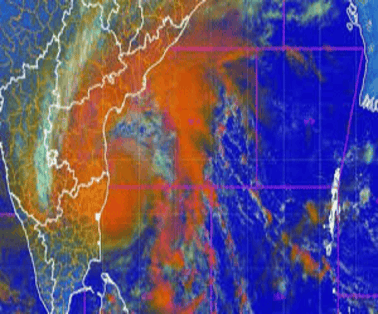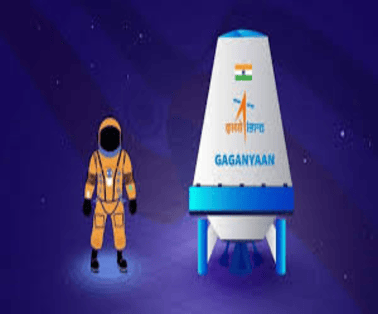Cyclone Michaung, the fourth tropical cyclone over the Bay of Bengal this year, has made landfall in Tamil Nadu and Andhra Pradesh, creating widespread attention. This cyclone, though initially predicted as a tropical storm, intensified and was upgraded to a severe storm. Let’s take a closer look at Cyclone Michaung, its formation, impact, and how it was named.
Key Points on Cyclone Michaung
- Cyclone Michaung has weakened into a depression over northeast Telangana
- December cyclones in the North Indian Ocean typically do not reach high intensities. Michaung, with its severe storm classification, is an exception.
- Initially predicted as a tropical cyclone, IMD upgraded Michaung to a ‘severe’ storm due to its unexpected intensification.
- The intensification is attributed to the above-normal heat index values off the southern Andhra Pradesh coast.
How Are Cyclones Formed?
- Tropical cyclones are formed over warm ocean water near the equator.
- Warm moist air near the surface of the ocean rises upwards. This creates a low-pressure area near the surface.
- This results in the movement of cooler air from surrounding areas into the low-pressure area.
- Now even this cool air becomes warm and moist and rises up. The above cycle keeps continuing.
- The warm moist air which rises up, cools the water in the air, resulting in the formation of clouds.
- This whole system of clouds and winds spins and grows. This entire cycle continues resulting in a cyclone.
Conditions For Cyclone Formation
The following conditions favour cyclone formation:
- The Surface Sea Temperature increases to 27° C and higher.
- Presence of Coriolis force
- Differences in Vertical wind speed
- Upper divergence above the sea level system
- Low pressure area
- Favourable Madden Julian Oscillation
- Ocean heat potential
Categories Of Tropical Cyclones
The IMD classifies cyclones on the basis of the Maximum Sustained Surface Wind Speed (MSW) they generate.
- The cyclones are classified as severe (MSW of 48-63 knots),
- Very severe (MSW of 64-89 knots),
- Extremely severe (MSW of 90-119 knots) and
Super cyclonic storm (MSW of 120 knots or more).
- One knot is equal to 1.8 kmph (kilometers per hour).
How Are Cyclones Named?
- A WMO/ESCAP (World Meteorological Organisation/United Nations Economic and Social Commission for Asia and the Pacific) Panel on Tropical Cyclones agreed in principle to assign names to the tropical cyclones in the Bay of Bengal and the Arabian Sea during its 27th session held in Muscat, Sultanate of Oman, in 2000.
- The naming of the tropical cyclones over the north Indian Ocean commenced from September 2004, with names provided by eight members
- The Regional Specialised Meteorological Centre (RSMC), New Delhi is responsible for naming the cyclonic storms formed over the Bay of Bengal and the Arabian Sea when they reach the relevant intensity.
- There are six RSMCs in the world, including the IMD and five Tropical Cyclone Warning Centres.
- The suggestion of names of cyclones in these regions including Northern Indian is given by countries such as India, Bangladesh, Maldives, Myanmar, Pakistan, Oman, Sri Lanka and Thailand.
Rules for Naming Cyclones Like Michaung
- The proposed names should be neutral to cultures, politics, gender and religious beliefs
- The name should not hurt the sentiments of the group of population in the world
- The name should not be rude or cruel in nature
- The PTC has rights to reject the names suggested by the countries
- The name should be short with less than 8 characters and easy to pronounce.
Panel On Tropical Cyclones
- The World Meteorological Organization (WMO) and the Economic and Social Commission for Asia and the Pacific (ESCAP) jointly established the Panel on Tropical Cyclones (PTC) in 1972 as an intergovernmental body.
- Its membership comprises countries affected by tropical cyclones in the Bay of Bengal and the Arabian Sea.
- The Panel is one of the five regional tropical cyclone bodies established as part of the WMO Tropical Cyclone Programme (TCP) which aims at promoting and coordinating the planning and implementation of measures to mitigate tropical cyclone disasters on a worldwide basis.
- For this purpose, there are Regional Specialized Meteorological Centre (RSMC) – Tropical cyclone and Tropical Cyclone Warning Centres (TCWC) for different regions.
- The main objective of the WMO/ESCAP Panel on Tropical Cyclones is to promote measures to improve tropical cyclone warning systems in the Bay of Bengal and the Arabian Sea.
Regional Names Of Cyclones
- Typhoons – China Sea
- Tropical Cyclones- Indian Ocean
- Hurricanes-Caribbean Sea
- Tornadoes-USA
- Wily Willies- Northern Australia
- Baguio- Philippines
- Taifu- Japan
When Is The Name Of A Tropical Cyclone Declared?
Names are declared when TCs are diagnosed with maximum sustained surface wind-speed of 34 knots (62 kmph) or more as per Global Data Processing and Forecasting System (GDPFS) Manual of WMO
About the World Meteorological Organization (WMO)
- The World Meteorological Organization (WMO) is a specialized agency of the United Nations.
- It originated from the International Meteorological Organization (IMO), which was founded in
- It became the specialized agency of the United Nations in 1951and named as World Meteorological Organization (WMO) for meteorology (weather and climate), operational hydrology and related geophysical sciences.
- It is the mouthpiece of UN systems of authoritative voice related to the state and behaviour of the Earth’s atmosphere- its interaction with the oceans, the climate it produces and the resulting distribution of water resources.
13 Member Nations Of WMO Are:
|
1. India |
2. Bangladesh |
|
3. Iran |
4. Myanmar |
|
5. Maldives |
6. Pakistan |
|
7. Oman |
8. Qatar |
|
9. Saudi Arabia |
10. Sri Lanka |
|
11. Thailand |
12. United Arab Emirates |
|
13. Yemen |
|
To Download Monthly Current Affairs PDF Click here
Click here to get a free demo
Everything About CLAT 2026



